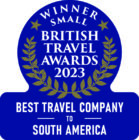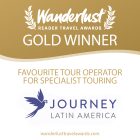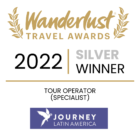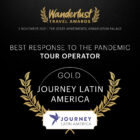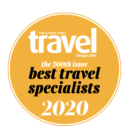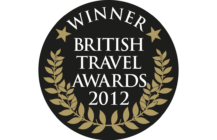Private Journeys
Self-drive Costa Rica: Coast to coast adventures
14 days
from £2,400pp

Overview & Highlights
With a good road network, Costa Rica is ideal for independent exploration by self-drive 4WD car. This action-packed holiday visits off-the-beaten-track national parks with a backdrop of volcanoes, mangroves and jungle. Your hotels are pre-booked for a more relaxed trip.
- Explore the waterways of Tortuguero National Park
- Discover off the beaten track rainforests and beaches
- Zipline or hike through lush jungles
Much of the enjoyment of self-drive holidays in Costa Rica is getting off the beaten track, onto the dirt tracks and rural roads where you can stop to explore at leisure. Begin your adventure among the mangrove forests of the wildlife-filled Tortuguero reserve. Discover the mysterious bird-filled cloud forest with its misty landscape of ferns and orchids, scramble over hanging bridges suspended over waterfalls and forest in the shadow of Arenal volcano and end your visit on a Pacific beach.
Costa Rica is a peaceful and stable country and its people are among the friendliest in Latin America. The comprehensive network of roads means that the national parks with their extensive trails are always accessible and self-drive is the perfect way for independent-minded, confident drivers and companions to explore.
An ideal destination to enjoy the great outdoors, Costa Rica is a hotspot for adventure tourism, with a range of activities on offer from zip-lining to white-water rafting. This tiny country is bursting with an extraordinary diversity of landscapes, flora and fauna.
Outline itinerary
Day 1
Arrive in San José and transfer to your hotel.
Day 2
Transfer by land and boat to Tortuguero on the Caribbean coast.
Day 3
Wildlife spotting excursions from your lodge.
Day 4
Pick up your rental car and drive to Sarapiqui.
Day 5
Explore Tirimbina Reserve before driving to Arenal Volcano.
Day 6
Visit La Fortuna Falls and the hanging bridges.
Day 7
Discover Caño Negro wildlife.
DAY 8
Drive from Arenal to Monteverde
Day 9
At leisure to discover forest trails and ride on a zip line.
Day 10
Drive from Monteverde to Rincón de la Vieja.
Day 11
At leisure to raft, hike or go horse-riding.
Day 12
Drive to the Pacific coast.
Day 13
At leisure on the beach.
Day 14
Drop off car at Liberia airport and take international flight home.
Itinerary
Day 1
Arrive in San José and transfer to your hotel.

Day 2
Transfer by land and boat to Tortuguero on the Caribbean coast.
Today you’ll head off to discover the Caribbean coast with a couple of days most rewarding wildlife spotting. This is true wilderness: it isn’t the Caribbean of resort hotels, sugary beaches and piña coladas. You’re driven for 3-4hr northeast, including a short bumpy ride through banana plantations to Caño Blanco dock.
Then you have an hour’s boat ride along the shore hugged by twisted mangrove swamps before you arrive in the small, ramshackle and remote village of Tortuguero and your lodge.

Day 3
Wildlife spotting excursions from your lodge.
Set off on a guided boat trip through the mangrove forest of Tortuguero National Park, now one of the last protected areas of tropical rainforest in Central America, with 11 different natural habitats and a huge range of endemic wildlife, much of which can be spotted as you glide through the water.
Three species of monkeys (spider, howler, and white-faced), three-toed sloths, and river otters are often seen along the natural inland waterways and canals. Caiman, iguanas, river turtles, lizards and poison dart frogs inhabit the area too, along with over 320 species of birds including 3 of toucan and 8 of parrot. The park was originally intended to conserve a major nesting beach of the Atlantic green sea turtle: if you travel between June and October you might be lucky enough to see them laying their eggs.

Day 4
Pick up your rental car and drive to Sarapiqui.
Return by boat to Caño Blanco dock and continue by road as far as Guapiles where you will be met by our representative who will deliver your hire car. Drive on a quiet rural road for approximately an hour to Sarapiqui.
The small town has become a popular base in which to take advantage of the wonderful forested national parks in the area, dispersed between banana and pineapple plantations. It has several low key hotels and restaurants. The Rio Sarapiquí runs just east of the main street and is popular for white water rafting.

Day 5
Explore Tirimbina Reserve before driving to Arenal Volcano.
The morning is at leisure to explore the Tirimbina Reserve, which caters for research and recreation in this rainforest environment including some walking trails, suspension bridges and a chocolate tour explaining about cacao cultivation in the area.
From Sarapiqui, it takes 1 ½ hours (75km) to reach La Fortuna, the main town in the foothills of Arenal Volcano.
A modest 1,674m high but an impressive conical mountain dominating the surroundings, Arenal Volcano last erupted in 1998. These days, lava flow and volcanic eruptions are infrequent and there has not been any significant activity since 2010. However, as seismic activity is often unpredictable the situation may change by the time you travel. Even without any recent volcanic activity, the region is still considered to be one of the highlights of a visit to Costa Rica.

Day 6
Visit La Fortuna Falls and the hanging bridges.
At leisure to explore the rainforest close to Arenal. There’s a 3km long trail taking you through primary forest over bridges so you get a real close-up experience as you spot wildlife and exotic plants. There should be good views of the Arenal volcano and neighbouring reservoir. The trail is linked by 6 hanging bridges and 80 fixed bridges, some measuring up to 22m in length and constructed from steel and aluminium to ‘blend with the natural environment.’ With a maximum grade of 7 degrees the carefully engineered trail is accessible to most ages and levels of fitness.

Day 7
Discover Caño Negro wildlife.
At leisure to explore Caño Negro. This remote reserve near the Nicaraguan border is a lowland forested wetland set up to protect migratory birds. It has become renowned for opportunities to observe water-loving birds, especially during migrations. It’s an enchanting 3hr boat trip up the Río Frío through the reserve to Caño Negro lake, a shallow overflow from the river in the wet season (it’s dry in March-April).
En route you’ll be watching out for sloths, monkeys, caimans, bats and tropical flora. It’s possible to drive the 1.5 to 2 hours to Los Chiles 4km from the border and trips into the park can be arranged from there or if you fancy a break from driving we can arrange it for you from La Fortuna where many trips depart from early in the morning.

DAY 8
Drive from Arenal to Monteverde
The drive from Arenal to Monteverde is only 110km but takes at least 4 hours. The first section to Tilarán skirts the northern shoreline of Lake Arenal on a winding, paved road and is particularly scenic with Arenal Volcano looming in your rear-view mirror.
Soon after Tilarán, the tarmac ends and the road becomes increasingly bumpy and at times quite steep, as it winds up through the mountains, past small farms and coffee plantations, to Monteverde. It can be slow going but the views are rewarding particularly on a clear day.

Day 9
At leisure to discover forest trails and ride on a zip line.
Visit the Monteverde Cloud Forest Reserve accompanied by a naturalist guide. The reserve includes a protected area comprising 6 different life zones. So many habitats in such a small area, along with extensive trail improvements, allow visitors to enjoy a rich diversity of flora and fauna with relatively short distance and easy walking.
The reserve was founded in 1972 and extends down both slopes of the Tilarán Mountains. It is home to more than 100 species of mammals, 400 of birds and 1,500 of plants. Walking along the well-marked trails, amidst dense, dripping foliage, you are likely to encounter the Resplendent quetzal (Jan – Jul. Occasionally a dozen or more individuals at once). Other species include the three-wattled bellbird, the emerald toucanet, and white-faced and howler monkeys.

Day 10
Drive from Monteverde to Rincón de la Vieja.
Follow a road through rural Costa Rica flanked by fields and low-lying vegetation. After 2.5hrs you arrive at a junction where you turn off onto a bumpy dirt track for a further 1.5hrs, with views of mist-swathed Rincón de La Vieja National Park.
The verdant park straddles the Guanacaste Cordillera. Its terrain ranges from tropical forest to lower mountain rainforest. There’s an abundance of wildlife particularly of birds and butterflies, and the country’s national flower – the cattleya skinneri orchid. The park’s main attraction though, is its active 1,895m volcano. There are also numerous waterfalls, fumaroles, boiling mud pools and geysers.

Day 11
At leisure to raft, hike or go horse-riding.
A wide range of classic Costa Rican outdoor activities can be undertaken from your lodge, including horse riding, mountain biking, zip-lining and white water rafting. There is also a choice of slower-paced nature tours, including a visit to a butterfly farm.

Day 12
Drive to the Pacific coast.
As you drive on through Guanacaste to the Pacific coast temperatures start to rise, the cool mist turns to a dry heat and the landscape takes on a golden glow. Start off on a gravel track following signs to Liberia (2hrs). It is a pleasant drive.
The lush rainforest gives way to more arid, scorched vegetation as temperatures soar in the coastal area of Guanacaste province. You are heading for the beach at Playa Panama, less than half an hour’s drive from Liberia.
Panama Beach’s rock-free, smooth, toffee-coloured sand is great for sunbathing. With its sheltered position south of Culebra Bay the swimming conditions are perfect. Additionally, the region’s abundant good weather may entice you out on the water: sailing, scuba diving, and sport fishing are popular activities. There are a number of resort hotels and other leisure developments currently under construction there but it remains a balmy, peaceful place with wonderful sunsets.

Day 13
At leisure on the beach.
At leisure to relax or explore the national park.

Day 14
Drop off car at Liberia airport and take international flight home.
Essentials
Tour info
Transport
2 transfers by road and boat, and a 4WD rental car.
Accommodation
This trip combines small, friendly mid-range hotels with well-equipped rooms and comfortable but not luxurious wildlife and beach lodges.
Meals
Breakfast daily, full board days 2,3.
Guides
We carefully select our local partners, some of whom we have worked with for over 25 years. Their English-speaking guides understand the expectations of our clients very well, and are consistently singled out for praise by the latter on their return.
Summary Of Nights
14 days, 13 nights: San José 1; Tortuguero 2; Sarapiqui 1; Arenal 3; Monteverde 2; Rincón de la Vieja 2; Golfo de Papagayo 2.
Currency
The unit of currency in Costa Rica is the colón.
How To Take It
Cash machines are available in San José: taking a debit or credit card with a PIN number is the most convenient way of withdrawing money while on your trip and in many shops and restaurants you can also pay by card. However, since cards can get lost, damaged, withheld or blocked, you should not rely exclusively on a card to access funds.
We recommend that additionally you take a reasonable quantity of US dollars cash (no more than is covered by your insurance), which you can exchange into local currency in San José at the beginning of your trip, and possibly some travellers’ cheques, though these are increasingly falling out of use. (American Express cheques are the most widely accepted). Dollar bills should be in good condition, soiled or torn bills may be refused. You can exchange sterling but the rate may be unfavourable and there are fewer outlets providing this service. US dollars cash is widely accepted for payments.
Daily Spend
It is very difficult to give a guideline for essential expenses but a budget of around US$40 per day should cover the cost of meals not included in the holiday itinerary, drinks and the odd souvenir. Eat at the best restaurants and you will pay considerably more.
Tipping
Tips are welcomed and local guides often rely on their tip as a significant proportion of their income.
Most service industry workers will expect a tip of some kind and so it is useful to have spare change for hotel porters, taxi drivers and the like. It is common to leave 10 – 12% in restaurants.
Insurance And Documents
Travel insurance is essential.
Details of our recommended policy can be found on our Travel Insurance page.
From 8 June 2015 new regulations will apply concerning the paper counterpart of UK driving licences. This may affect what is required by the rental company when you collect your car.Please check https://www.gov.uk/government/news/driving-licence-changes for further details.
Additional Liability and Loss Damage Waiver (CDW without excess and inclusion of theft protection) is included as well as Personal Accident and Third Party insurance.
Airport Taxes
If you have purchased your flights through Journey Latin America, the international departure tax is usually included in the ticket.
Trip Suitability
There are no really long days of travel on the suggested routes of this trip. The routes from A to B take about 4 – 5hrs but you may well want to make a detour or stop off for a while. Roads are generally in good condition but some are unpaved and bumpy and less used routes may have potholes. Signage on major roads is good, less so on minor roads. Many people speak a little English but a smattering of Spanish will stand you in good stead.
If you have a disability that we need to be aware of, please contact us.
In the months of May to August the weather is extremely hot and humid, you might want to bear this in mind. July to November there are chances of tropical storms or hurricanes hitting the region.
Climate
The trip covers climates ranging from tropical lowland to more temperate zones in the highlands. Those travelling between May and October journeys should encounter high temperatures (around 35°C) and high humidity in the lowlands. The ‘official’ rainy (green) season is May to October.
December to April visitors will still encounter high temperatures in lowland areas, but cool evenings around Arenal and San José with temperatures falling to around 5°C. Rainfall and humidity will be lower at this time.
Clothing And Special Equipment
For day-to-day wear you should take loose-fitting, breathable clothes. Comfortable shoes are important and sandals are useful. A sun hat, sun block and sunglasses are necessary, and you should take a light fleece for cool nights and a breathable/waterproof outer layer and/or umbrella, as well as swimwear, a towel, insect repellent and a torch. A rain jacket and fleece are advisable for the cooler mountain region. If you plan to go to good restaurants or out for evening entertainment, you might bring something a bit smarter as well (although formal attire will not be required).
Please get in touch with the Journey Latin America office before departure if you have any doubts.
Sat-navs do work in Costa Rica so may want to take your own or we can arrange the hiring of one . We recommend that you always take a map as a back up!
Vaccinations
Preventative vaccinations are recommended against the following; typhoid; polio; tetanus; hepatitis A. For specific requirements you must consult your GP.
You can also find helpful information on the Masta Travel Health website.
Visas
Holders of a full British passport do not require a visa, although passports must be valid for at least 6 months after the trip begins. Anyone with a different nationality should enquire with us or check with the relevant consulate.
If flying to the US, or via the US you will need to fill in your online ESTA application.
What's included in the price
- Services of our team of experts in our London office
- Services of Journey Latin America local representatives and guides
- Car hire
- All land and water transport
- Accommodation as specified
- Meals as specified
- Excursions as specified, including entrance fees
Included Excursions
- Tortuguero: Explorations at Tortuguero National Park
What's not included in the price
- Tips and gratuities
- Flights to and from the UK
- Meals other than specified
- Airport taxes, when not included in the ticket
- Optional Excursions








